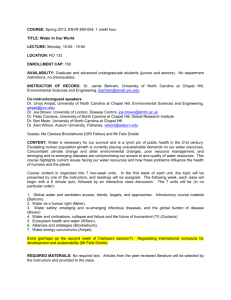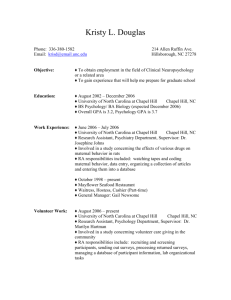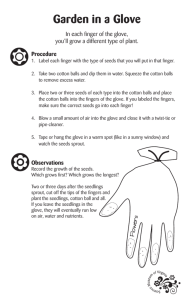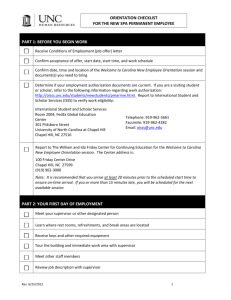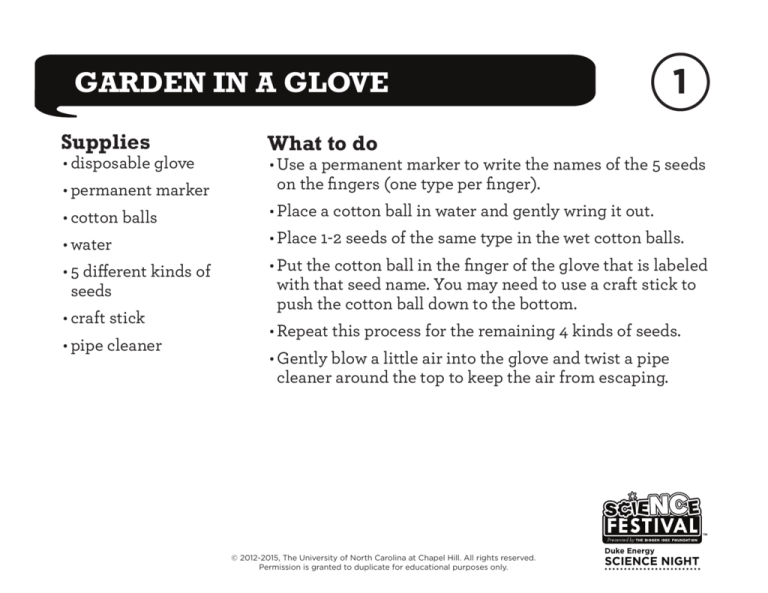
1
GARDEN IN A GLOVE
Supplies
•disposable glove
•permanent marker
•cotton balls
•water
•5 different kinds of
seeds
•craft stick
•pipe cleaner
What to do
•Use a permanent marker to write the names of the 5 seeds
on the fingers (one type per finger).
•Place a cotton ball in water and gently wring it out.
•Place 1-2 seeds of the same type in the wet cotton balls.
•Put the cotton ball in the finger of the glove that is labeled
with that seed name. You may need to use a craft stick to
push the cotton ball down to the bottom.
•Repeat this process for the remaining 4 kinds of seeds.
•Gently blow a little air into the glove and twist a pipe
cleaner around the top to keep the air from escaping.
© 2012-2015, The University of North Carolina at Chapel Hill. All rights reserved.
Permission is granted to duplicate for educational purposes only.
Duke Energy
SCIENCE NIGHT
SCIENCE NIGHT
Duke Energy
3. When your seeds have roots, you can plant
them in a container using potting soil. Cut
the finger off the glove and throw away
the plastic. If you can’t separate the roots
from the cotton, plant the cotton and roots
together in potting soil.
2. Once the seeds have sprouted and leaves
begin to appear, hang the glove in a sunny
window.
1. Keep the glove in a warm place until the
seeds germinate.
When you get home:
© 2012-2015, The University of North Carolina at Chapel Hill. All rights reserved.
Permission is granted to duplicate for educational purposes only.
Each seed contains a baby plant and food
for initial growth. The seeds will germinate
(begin to grow/sprout) in about 5 to 7 days.
Transplant (remove and plant in another
place) the seeds after about 14 days by cutting the tips off the fingers of the glove. Take
the seedling out of the plastic and place the
cotton ball and germinated seeds into a small
pot or cup of soil. Watch your garden grow!
What’s Happening?
1
SCIENCE NIGHT
Duke Energy
3. When your seeds have roots, you can plant
them in a container using potting soil. Cut
the finger off the glove and throw away
the plastic. If you can’t separate the roots
from the cotton, plant the cotton and roots
together in potting soil.
2. Once the seeds have sprouted and leaves
begin to appear, hang the glove in a sunny
window.
GARDEN
GARDEN IN
IN A
A GLOVE
GLOVE
At-Home Guide
1
1. Keep the glove in a warm place until the
seeds germinate.
When you get home:
© 2012-2015, The University of North Carolina at Chapel Hill. All rights reserved.
Permission is granted to duplicate for educational purposes only.
Each seed contains a baby plant and food
for initial growth. The seeds will germinate
(begin to grow/sprout) in about 5 to 7 days.
Transplant (remove and plant in another
place) the seeds after about 14 days by cutting the tips off the fingers of the glove. Take
the seedling out of the plastic and place the
cotton ball and germinated seeds into a small
pot or cup of soil. Watch your garden grow!
What’s Happening?
At-Home Guide
GARDEN
GARDEN IN
IN A
A GLOVE
GLOVE
2
BUBBLE CHALLENGES
Can you blow a bubble...
… bigger than your head?
… within a bubble?
… on top of another bubble?
… that doesn’t pop when you catch it with
your hands?
© 2012-2015, The University of North Carolina at Chapel Hill. All rights reserved.
Permission is granted to duplicate for educational purposes only.
Duke Energy
SCIENCE NIGHT
3
GROSS GOO (PRE-EVENT)
Supplies
•2–4 clean, empty 2-liter
soda bottles with a lid
•borax
•glue
•water
•1-cup measuring cup
Borax and Water Solution
In a clean, empty 2-liter soda bottle combine 1 cup of borax
with warm water. For best results, combine small amounts
of borax and water at a time. Fill the bottle with water.
Put the cap on the bottle and shake to dissolve the borax.
Periodically shake this solution throughout the event. Pour
some of this solution into a cup (about ¾ full) and save the
rest to top off the cup throughout the event.
Glue and Water Solution
**Be prepared to make
more of these mixtures
throughout the night,
depending on attendance.**
In a clean 2-liter soda bottle combine equal parts white
glue and water. It works best to start with the glue and then
add the water. Leave some room at the top of the bottle. Put
the cap on the bottle and gently shake to mix the glue and
water. If you are expecting a large crowd you may want to
go ahead and make two batches. Pour some of this solution
into a cup (about ¾ full) and save the rest to top off the cup
throughout the event.
© 2012-2015, The University of North Carolina at Chapel Hill. All rights reserved.
Permission is granted to duplicate for educational purposes only.
Duke Energy
SCIENCE NIGHT
3
GROSS GOO
Supplies
What to do
•sealable plastic bag
•Open your plastic bag and hold it at the top
to keep it open.
•pipettes
•glue and water solution
•food coloring
•borax and water
solution
•Add 30mL (about 6 full pipette squirts) of the glue
solution into your bag.
•If you would like to make your goo a color, add 2 drops
of food coloring to your bag.
•Add 10mL (about 2 full pipette squirts) of the Borax
solution to your bag.
•Carefully seal your bag. Double check to make sure that
it is closed, and use your hands to knead the mixture
together. Mix thoroughly — just be careful not to
pop the bag!
© 2012-2015, The University of North Carolina at Chapel Hill. All rights reserved.
Permission is granted to duplicate for educational purposes only.
Duke Energy
SCIENCE NIGHT
4
INVISIBLE INK
Supplies
•goldenrod paper
•cotton swabs
•vinegar
•water
What to do
•Dip a cotton swab into one of solutions. Draw or write on your
paper. Did anything happen?
•Using a new cotton swab, try one of the other solutions. What
happened this time?
•baking soda solution
WATER
VINEGAR
© 2012-2015, The University of North Carolina at Chapel Hill. All rights reserved.
Permission is granted to duplicate for educational purposes only.
BAKING SODA
SOLUTION
Duke Energy
SCIENCE NIGHT
5
SOUND SANDWICH
Supplies
•Stack the second craft stick on top of the
straws.
•1 big rubber band
•Wrap the little rubber bands around the
ends of the craft sticks to hold the stack
together.
•2 jumbo craft sticks
•2 little rubber bands
•2 inch-long straw
pieces
What to do
•Wrap the big rubber band long-ways
around one of the jumbo craft sticks.
•Slide the two straw pieces under the
rubber band and push one toward each
end of the craft stick.
Play your Sound Sandwich
•Purse your lips (like you are about to say
“pop”) and blow between the two craft
sticks.
•Try moving the straws closer together and
blow through the middle again. Did moving
the straws change anything?
© 2012-2015, The University of North Carolina at Chapel Hill. All rights reserved.
Permission is granted to duplicate for educational purposes only.
Duke Energy
SCIENCE NIGHT
6
MARSHMALLOW CHALLENGES
Try to build
… a tower taller than you
… a tower with a narrow base
… a bridge
… a new wing on someone else’s building
… a building with a hole big enough for your
arm to fit through
© 2012-2015, The University of North Carolina at Chapel Hill. All rights reserved.
Permission is granted to duplicate for educational purposes only.
Duke Energy
SCIENCE NIGHT
6
MARSHMALLOW SHAPES
Make triangles and squares.
Then try putting them together.
4 triangles
6 squares
Can you make a shape out of 1 square and 4 triangles?
© 2012-2015, The University of North Carolina at Chapel Hill. All rights reserved.
Permission is granted to duplicate for educational purposes only.
Duke Energy
SCIENCE NIGHT
7
FINGERPRINT PATTERNS
Arch
Loop
Whorl
Ridges form a hill or
tent-shaped pattern.
Ridges form an elongated
loop pattern.
Ridges form a circular
pattern.
© 2012-2015, The University of North Carolina at Chapel Hill. All rights reserved.
Permission is granted to duplicate for educational purposes only.
Duke Energy
SCIENCE NIGHT
8
MY GENES BRACELET
Take a look at your earlobes. Do they hang free or are they
attached to your head?
If your earlobes are free,
add a bright pink bead.
This trait is dominant.
If your earlobes are attached,
add a light pink bead.
This trait is recessive.
© 2012-2015, The University of North Carolina at Chapel Hill. All rights reserved.
Permission is granted to duplicate for educational purposes only.
Duke Energy
SCIENCE NIGHT
8
MY GENES BRACELET
Try to roll your tongue like a taco. Can you do it?
If you can roll your tongue,
add an orange bead.
This trait is dominant.
If you can’t roll your tongue,
add a peach bead.
This trait is recessive.
© 2012-2015, The University of North Carolina at Chapel Hill. All rights reserved.
Permission is granted to duplicate for educational purposes only.
Duke Energy
SCIENCE NIGHT
8
MY GENES BRACELET
Pull your hair back from your forehead. Is your hairline pointed
or straight?
If you have a pointed hairline,
add a yellow bead.
This trait is dominant.
If you have a straight hairline,
add an ivory bead.
This trait is recessive.
© 2012-2015, The University of North Carolina at Chapel Hill. All rights reserved.
Permission is granted to duplicate for educational purposes only.
Duke Energy
SCIENCE NIGHT
8
MY GENES BRACELET
Smile! Do you have any dimples in your cheeks?
If you have any dimples,
add a green bead.
This trait is dominant.
If you don’t have any dimples,
add a light green bead.
This trait is recessive.
© 2012-2015, The University of North Carolina at Chapel Hill. All rights reserved.
Permission is granted to duplicate for educational purposes only.
Duke Energy
SCIENCE NIGHT
8
MY GENES BRACELET
Clasp your hand together naturally. Which thumb is on top?
If your left thumb is on top,
add a blue bead.
This trait is dominant.
If your right thumb is on top,
add a light blue bead.
This trait is recessive.
© 2012-2015, The University of North Carolina at Chapel Hill. All rights reserved.
Permission is granted to duplicate for educational purposes only.
Duke Energy
SCIENCE NIGHT
8
MY GENES BRACELET
Look at the middle section of your fingers. Can you see hair on
any of them?
If you have any hair at all,
add a purple bead.
This trait is dominant.
If you don’t have any hair,
add a light purple bead.
This trait is recessive.
© 2012-2015, The University of North Carolina at Chapel Hill. All rights reserved.
Permission is granted to duplicate for educational purposes only.
Duke Energy
SCIENCE NIGHT
9
PAPER FLYING MACHINES
Straw Glider
Cut an index card into three vertical pieces.
Roll one piece into a small loop and tape it shut.
Tape the other two pieces together, then
make a large loop and tape it shut.
Place your straw inside the two loops.
Tape the straw to the inside of the loops.
To fly, hold the straw, then throw it like a spear with
the little loop in front and both loops pointing up.
Whirligig
Cut a strip of paper longer than it is wide.
Cut notches near each end from opposite sides of
the paper.
Fold the strip into a loop and connect the notches.
Hold your Whirligig high above your head.
Let go and watch it twirl as it floats down.
Experiment: how should you hold it to make it twirl?
© 2012-2015, The University of North Carolina at Chapel Hill. All rights reserved.
Permission is granted to duplicate for educational purposes only.
Duke Energy
SCIENCE NIGHT
10
PARACHUTES
What to do
•Cut four equal length pieces of string,
each approximately 12 inches long.
•Unfold a paper napkin so that it is
laying flat.
•Use a sticker to secure one piece of
string at each corner of the napkin.
•Bring the loose ends of the strings
together and thread them through one
end of a paperclip.
Test your parachute
•Hold your parachute up so that the
strings and paperclip hang down, then
drop.
•How close to the center of the target
can you land your paperclip?
•Are there any changes you could make
to your parachute to make it land more
accurately?
•Fold the loose ends of the string up to
form a loop (the paperclip should hang
down from the loop).
•Tie a knot or wrap a sticker around the
loose strings to secure the loop and the
paperclip.
© 2012-2015, The University of North Carolina at Chapel Hill. All rights reserved.
Permission is granted to duplicate for educational purposes only.
Duke Energy
SCIENCE NIGHT
11
CREATE-A-COASTER
Supplies
•foam tubes
•masking tape
•clips
•marble
•milk jug, coffee can or
cup
What to do
•Use masking tape to attach one end of a piece of foam
tube to a wall (about 3-4 ft. up from the floor) or to the
back of a chair.
•Prop up the end of the track on books or boxes.
•Position your container at the base to catch the marble as
it reaches the end of the track.
•What other designs can be made using these same
materials?
© 2012-2015, The University of North Carolina at Chapel Hill. All rights reserved.
Permission is granted to duplicate for educational purposes only.
Duke Energy
SCIENCE NIGHT
12
STOMP ROCKETS
Supplies
•wooden dowel
•construction paper
•tape
•scissors
What to do
•Wrap a piece of construction paper tightly around the dowel.
Once completely wrapped, tape to hold in place.
•Make a nose cone and attach to the top of your rocket. Make
sure your nose cone is air-tight for a successful launch.
•Slide the rocket off the dowel and try a test launch!
•Try attaching fins to the back of your rocket – does it change
the way it flies?
© 2015, The University of North Carolina at Chapel Hill. All rights reserved.
Permission is granted to duplicate for educational purposes only.
Duke Energy
SCIENCE NIGHT


